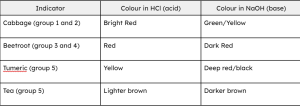Aim: why did we do the experiment?
- The reason why we did the experiment is to get real life experience and the results of doing it in real life
Equipment: what did you use for your experiment?
-
- Spotting tiles
- Pipettes
- Universal indicator
- Litmus paper
- 7Up (The worst drink for your body)
- Floor cleaner
- Vinegar
- Toilet cleaner
- Fabric softener
Method: what steps did you complete to get your results for your experiment? Make sure your steps are numbered (like a recipe)
- 1. Put on safety goggles
- 2. Get your equipment ready
- 3. Grab your spotting tile
- 4. Pour a bit of each liquid into each indent of the spotting tile
- 5. Use litmus paper/universal indicator to discover if its acidic, neutral or basic
- 6. Write down your results
Results: Pictures + link to your results table
- We sadly don’t have any pictures of the experiment, however, we do have a results table:

Discussion: starting discussion questions (you can include more detail)
-
- Why did different household chemicals change different colours? Link this to the ions present:
Household chemicals change colour because of the different ions they contain and their pH levels. Certain ions reflect light in unique ways, leading to various colours, especially with transition metals. For example, litmus paper turns red in acids and blue in bases, while phenolphthalein is colourless in acids and pink in bases. Reactions, like mixing baking soda and vinegar, can also cause colour changes.
- Why did different household chemicals change different colours? Link this to the ions present:
- How did you know if these chemicals were acidic or basic? Answer this question for both U.I and litmus:
Litmus paper has two colours, blue and red. Red litmus paper is used for basic liquids, you dip the red litmus paper in something basic and it turns red, dip it in something acidic and nothing changes. The exact opposite is used for blue litmus paper, dip it in something acidic and it turns red, dip it in something basic and nothing happens.
Universal indicator is a liquid that is similar to litmus paper but it always changes.
- Why might Universal indicator (U.I) be more useful than Litmus paper?
Litmus paper can only be used to see if its acidic or basic, Universal indicator can be used to not only see the exact pH level but it can also be used more than once.
Conclusion: starting conclusion questions (you can include more detail)
-
- did all your experiments work – if they didn’t, why?
- Our group had a bit of trouble at the start, with one of my teammates breaking a beaker. Other than that little accident, nothing went wrong
what could you do to improve your science next time? Think about the reliability of your data
- A few things we could have done better would be:
- Not breaking lab equipment
- Using a larger range of household chemicals
- Not having someone squirt their chemicals in our pH indicators
 )]
)]
